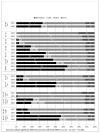Changes in use of long-acting contraceptive methods in the United States, 2007-2009
- PMID: 22795639
- PMCID: PMC3462302
- DOI: 10.1016/j.fertnstert.2012.06.027
Changes in use of long-acting contraceptive methods in the United States, 2007-2009
Abstract
Objective: To examine trends in the use of long-acting reversible contraceptive (LARC) methods-the intrauterine device (IUD) and implant--and the extent to which these methods have replaced permanent sterilization and less effective short-acting methods.
Design: We tabulated data from female survey respondents overall and by demographic subgroups. We performed t-tests of the differences in the proportions of female contraceptors using LARC in 2007 and 2009. We also looked at use of LARC, sterilization, other methods, and no method among women at risk of unintended pregnancy.
Setting: In-home survey.
Patient(s): All female respondents to the surveys.
Intervention(s): None.
Main outcome measure(s): Current use of LARC methods in 2009, and change in use from 2007.
Result(s): The proportion of contraceptors using LARC increased significantly from 2.4% in 2002 to 3.7% in 2007 and 8.5% in 2009. The increase occurred among women in almost every age, race, education, and income group. Among women at risk of unintended pregnancy, increases in LARC use more than offset decreases in sterilization.
Conclusion(s): LARC methods (primarily IUDs) are contributing to an increase in contraceptive effectiveness in the United States.
Copyright © 2012 American Society for Reproductive Medicine. All rights reserved.
Figures
References
-
- Hatcher RA, Trussell J, Nelson AL, Cates W, Jr, Stewart FH, Kowal D. Contraceptive Technology. 19. New York: Ardent Media; 2007.
-
- Finer LB. Unintended pregnancy among U.S. adolescents: accounting for sexual activity. J Adolesc Health. 2010;47:312–4. - PubMed
-
- Centers for Disease Control and Prevention. [Accessed January 19, 2012.];Unintended pregnancy prevention. Available at: http://www.cdcgov/reproductivehealth/unintendedpregnancy/
Publication types
MeSH terms
Substances
Grants and funding
LinkOut - more resources
Full Text Sources
Medical


